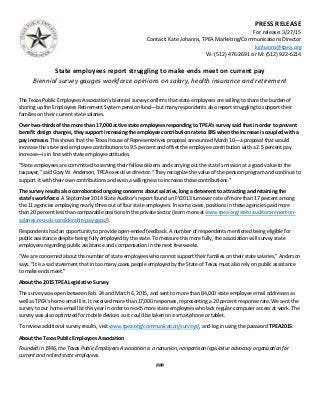2015_03_27_TPEA_Press_Release_State_Employee_Survey_Results
•
0 j'aime•37 vues
Signaler
Partager
Signaler
Partager
Télécharger pour lire hors ligne

Recommandé
Recommandé
More than Just Lines on a Map: Best Practices for U.S Bike Routes
This session highlights best practices and lessons learned for U.S. Bike Route System designation, as well as how and why these routes should be integrated into bicycle planning at the local and regional level.
Presenters:
Presenter: Kevin Luecke Toole Design Group
Co-Presenter: Virginia Sullivan Adventure Cycling AssociationMore than Just Lines on a Map: Best Practices for U.S Bike Routes

More than Just Lines on a Map: Best Practices for U.S Bike RoutesProject for Public Spaces & National Center for Biking and Walking
Contenu connexe
En vedette
More than Just Lines on a Map: Best Practices for U.S Bike Routes
This session highlights best practices and lessons learned for U.S. Bike Route System designation, as well as how and why these routes should be integrated into bicycle planning at the local and regional level.
Presenters:
Presenter: Kevin Luecke Toole Design Group
Co-Presenter: Virginia Sullivan Adventure Cycling AssociationMore than Just Lines on a Map: Best Practices for U.S Bike Routes

More than Just Lines on a Map: Best Practices for U.S Bike RoutesProject for Public Spaces & National Center for Biking and Walking
En vedette (20)
Content Methodology: A Best Practices Report (Webinar)

Content Methodology: A Best Practices Report (Webinar)
How to Prepare For a Successful Job Search for 2024

How to Prepare For a Successful Job Search for 2024
Social Media Marketing Trends 2024 // The Global Indie Insights

Social Media Marketing Trends 2024 // The Global Indie Insights
Trends In Paid Search: Navigating The Digital Landscape In 2024

Trends In Paid Search: Navigating The Digital Landscape In 2024
5 Public speaking tips from TED - Visualized summary

5 Public speaking tips from TED - Visualized summary
Google's Just Not That Into You: Understanding Core Updates & Search Intent

Google's Just Not That Into You: Understanding Core Updates & Search Intent
The six step guide to practical project management

The six step guide to practical project management
Beginners Guide to TikTok for Search - Rachel Pearson - We are Tilt __ Bright...

Beginners Guide to TikTok for Search - Rachel Pearson - We are Tilt __ Bright...
Unlocking the Power of ChatGPT and AI in Testing - A Real-World Look, present...

Unlocking the Power of ChatGPT and AI in Testing - A Real-World Look, present...
More than Just Lines on a Map: Best Practices for U.S Bike Routes

More than Just Lines on a Map: Best Practices for U.S Bike Routes
Ride the Storm: Navigating Through Unstable Periods / Katerina Rudko (Belka G...

Ride the Storm: Navigating Through Unstable Periods / Katerina Rudko (Belka G...
2015_03_27_TPEA_Press_Release_State_Employee_Survey_Results
- 1. PRESS RELEASE For release: 3/27/15 Contact: Kate Johanns, TPEA Marketing/Communications Director kjohanns@tpea.org W: (512) 476-2691 or M: (512) 922-6214 State employees report struggling to make ends meet on current pay Biennial survey gauges workforce opinions on salary, health insurance and retirement The Texas Public Employees Association’s biennial survey confirms that state employees are willing to share the burden of shoring up the Employees Retirement System pension fund—but many respondents also report struggling to support their families on their current state salaries. Over two-thirds of the more than 17,000 active state employees responding to TPEA’s survey said that in order to prevent benefit design changes, they support increasing the employee contribution rate to ERS when the increase is coupled with a pay increase. This shows that the Texas House of Representatives proposal announced March 10—a proposal that would increase the state and employee contributions to 9.5 percent and offset the employee contribution with a 2.5 percent pay increase—is in line with state employee attitudes. “State employees are committed to serving their fellow citizens and carrying out the state’s mission at a good value to the taxpayer,” said Gary W. Anderson, TPEA executive director. “They recognize the value of the pension program and continue to support it with their own contributions and even a willingness to increase those contributions.” The survey results also corroborated ongoing concerns about salaries, long a deterrent to attracting and retaining the state’s workforce. A September 2014 State Auditor’s report found an FY2013 turnover rate of more than 17 percent among the 11 agencies employing nearly three out of four state employees. In some cases, positions in these agencies paid more than 20 percent less than comparable positions in the private sector (learn more at www.tpea.org/state-auditors-report-on- salaries-reveals-considerable-pay-gaps/). Respondents had an opportunity to provide open-ended feedback. A number of respondents mentioned being eligible for public assistance despite being fully employed by the state. To measure this more fully, the association will survey state employees regarding public assistance and compensation in the next few weeks. “We are concerned about the number of state employees who cannot support their families on their state salaries,” Anderson says. “It is a sad statement that in too many cases people employed by the State of Texas must also rely on public assistance to make ends meet.” About the 2015 TPEA Legislative Survey The survey was open between Feb. 24 and March 6, 2015, and sent to more than 84,000 state employee email addresses as well as TPEA’s home email list. It received more than 17,000 responses, representing a 20 percent response rate. We sent the survey to our home email list this year in order to reach more state employees who lack regular computer access at work. The survey was also optimized for mobile devices so it could be taken on a smartphone or tablet. To review additional survey results, visit www.tpea.org/communication/surveys/, and log in using the password TPEA2015. About the Texas Public Employees Association Founded in 1946, the Texas Public Employees Association is a nonunion, nonpartisan legislative advocacy organization for current and retired state employees. ###